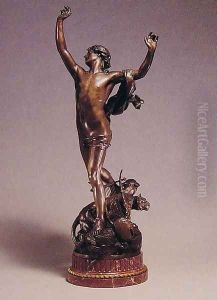Charles Raoul Verlet Paintings
Charles Raoul Verlet was a French sculptor born on November 7, 1857, in Angoulême, France. He pursued his passion for art from a young age and was admitted to the École des Beaux-Arts in Paris, where he studied under renowned sculptors such as François Jouffroy and Jules Cavelier. Verlet's education and talent in the arts were evident, and he quickly became known for his classical style, which was characterized by its adherence to traditional forms and techniques prevalent during his time.
Verlet's career was marked by numerous accomplishments and recognitions. He exhibited his work at the Paris Salon, an official art exhibition of the Académie des Beaux-Arts in Paris, and received several awards for his sculptures, including medals in the years 1889 and 1900. He was also honored with the distinction of the Chevalier of the Legion of Honour, which is one of France's highest orders of merit for military and civil merits.
Among Verlet's notable works are public monuments and memorials that garnered much attention and praise. One of his most significant contributions was his involvement in the decoration of the Petit Palais, built for the 1900 Universal Exhibition in Paris. His sculptures are characterized by a sense of realism and often depict allegorical or mythological subjects, reflecting the artistic tendencies of the late 19th and early 20th centuries. Verlet's approach to sculpture was traditional, focusing on the human form with meticulous attention to detail and composition.
Charles Raoul Verlet passed away on February 2, 1923, leaving behind a legacy of classical sculptures that continue to be appreciated for their technical skill and aesthetic beauty. His works remain an integral part of France's cultural heritage and can be seen in various museums and public spaces throughout the country. Verlet's influence on French sculpture during the Belle Époque era is still recognized by art historians and enthusiasts today.
